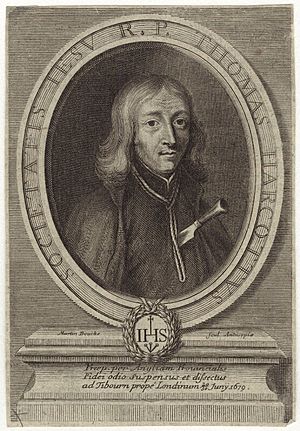Thomas Whitbread facts for kids
Quick facts for kids BlessedThomas Whitbread SJ |
|
|---|---|

Engraving of Thomas Whitbread (using his alias Harcourt) by Martin Bouché, 1683, National Portrait Gallery
|
|
| Martyr | |
| Born | 1618 Essex, England |
| Died | 20 June 1679 (aged 60–61) Tyburn, London |
| Honored in | Roman Catholic Church |
| Beatified | 15 December 1929 by Pope Pius XI |
| Feast | 20 June |
Thomas Whitbread (also known as Harcourt) was an English Jesuit priest. He lived from 1618 to 1679. He was a missionary who worked to spread his faith in England. Sadly, he was wrongly accused of planning to kill King King Charles II. This happened during a time called the Popish Plot. He was later executed. In 1929, the Catholic Church recognized him as "Blessed" Thomas Whitbread. His special day is celebrated on June 20.
Early Life and Work
Thomas Whitbread was born in Essex, England, in 1618. We do not know much about his family or his very early life. He went to school at St. Omer's. This was a college for English Catholics in France.
In 1635, he joined the Society of Jesus, also known as the Jesuits. This is a religious group within the Catholic Church. He became a priest and returned to England in 1647. For over 30 years, he worked as a missionary. He spent most of his time helping people in the eastern parts of England.
Thomas Whitbread became an important leader among the Jesuits in England. He was in charge of different areas. In 1678, he became the Provincial. This meant he was the main leader of the Jesuits in England.
It is said that Thomas Whitbread had a feeling that trouble was coming. In July 1678, he gave a famous speech in Liège. He warned his listeners that the peaceful times would not last. He told them they might face false accusations and suffering. He even spoke about being imprisoned and becoming a martyr. After his travels, he returned to England. Soon after, he became very ill with the plague.
Facing False Accusations
Thomas Whitbread was arrested in London on September 29, 1678. He was so sick that he could not be moved to Newgate Prison for three months. He had been staying in a house that was part of the Spanish Embassy. Usually, people in an embassy have special protection. But for some reason, this protection was not used for him.
He was first put on trial in December 1678. The main accuser was a man named Titus Oates. Oates claimed he heard Whitbread and other Jesuits planning to kill the King. He said this meeting happened in a tavern in London. However, no one else could confirm Oates's story. Whitbread strongly denied the accusations. He said he had never been to that tavern. Because there was not enough proof, the case against him and his friends fell apart.
Trial and Execution
Even though the first trial failed, people in power did not want Thomas Whitbread to go free. Many people at the time believed the stories about the Popish Plot. So, Whitbread was kept in prison.
On June 13, 1679, he was put on trial again. This time, he and four other men were found guilty. The evidence against them was false. It came from Oates and other people who lied. The trial was very important. Seven judges, led by Sir William Scroggs, heard the case. Scroggs believed the plot was real and was against Catholic priests.
In this situation, Thomas Whitbread had little hope of escaping. He continued to say he was innocent. But it seems he had accepted that he would die. His speech from the year before showed he expected to become a martyr.
He was sentenced to be executed by hanging. He was taken to Tyburn, a place in London where executions happened. The crowd watching the execution seemed to feel sympathy for the men. They listened quietly as Whitbread and the others spoke. They all said they were innocent. The other men executed with him were John Gavan, John Fenwick, William Harcourt, and Anthony Turner. After their deaths, their bodies were buried in St. Giles's in the Fields.
His Writings
Thomas Whitbread wrote a book called Devout Elevation of the Soul to God. He also wrote two short poems. These poems were called To Death and To His Soul. They can be found in a collection called The Remonstrance of Piety and Innocence.

